|  
 | | | | 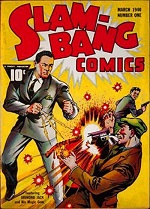

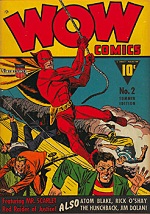

| | Fawcett Comics (Anthologies)
First time travel: Slam-Bang Comics 1, Mar 1940

 Apart from Captain Marvel Fawcett also had other comics, some with time travel, such as Atom Blake who met himself in time in Wow Comics 2 and Nyoka, the Jungle Girl who traveled to prehistoric times in issue 10. Apart from Captain Marvel Fawcett also had other comics, some with time travel, such as Atom Blake who met himself in time in Wow Comics 2 and Nyoka, the Jungle Girl who traveled to prehistoric times in issue 10.

The earliest that I know of (courtesy of Buddy Lortie) is the continuing story of Mark Swift, his teacher Mr. Kent, and the Time Retarder, which ran in all seven issues of Slam-Bang Comics and finished its run in Master Comics 7. Another continuing character was Dr. Voodoo who began life in the comics as a jungle doctor, but had an adventure in the past in Whiz Comics 18 through 34.

As I find more of those, I’ll list them on my time-travel comics page. Where are we going first, Mr. Kent? Where are we going first, Mr. Kent? 
| |
| | | | |

 | | | | 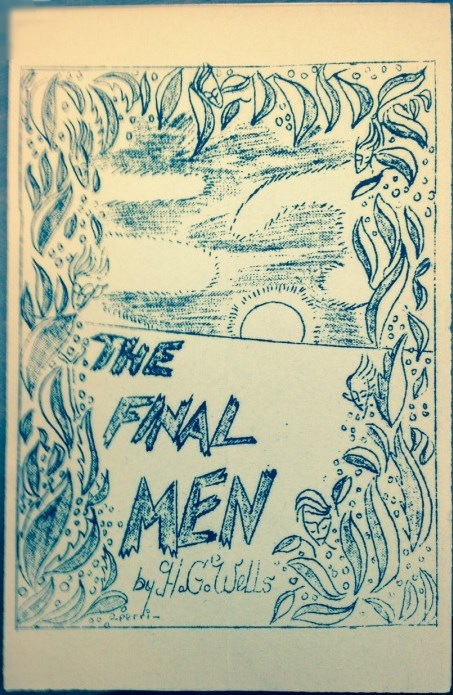 from the Hevelin Collection at the University of Iowa from the Hevelin Collection at the University of Iowa

| | “The Final Men”
by H.G. Wells
First separate publication: Mar 1940 by Futurian Robert W. Lowndes

The first complete, published version of The Time Machine appeared as a five-part serial in the January through May 1895 issues of New Review, edited by William Ernest Henley. In the introduction to the 1924 edition, Wells wrote about the back-and-forth between himself and Henley, saying that “There was a slight struggle between the writer and W.E. Henley who wanted, he said, to put a little ‘writing’ into the tale.”

One piece of that writing was a short episode after the traveller leaves the Eloi and the Morlocks, just before visiting the red sun and the end of the world. This episode was deleted from both the American (Holt text) and the British (Heinemann text) published book editions of the novel, but it did appear as a 7-page mimeographed and stapled publication from American fan and Futurian Robert W. Lowndes in 1940, and it appeared in a number of other places, sometimes called “The Grey Man” and once called “The Missing Pages.” No doubt, too, the rain and snow had long since washed out the Morlock tunnels. A nipping breeze stung my hands and face. So far as I could see there were neither hills, nor trees, nor rivers: only an uneven stretch of cheerless plateau. No doubt, too, the rain and snow had long since washed out the Morlock tunnels. A nipping breeze stung my hands and face. So far as I could see there were neither hills, nor trees, nor rivers: only an uneven stretch of cheerless plateau. 
| |
| | | | |

 
 | | | | 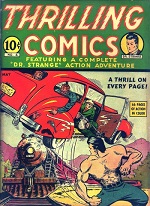

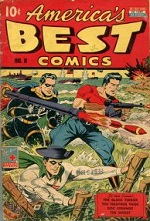



| | The Ghost
aka The Ghost Detective, aka The Green Ghost, aka The Ghost Super-Detective
by August Froehlich and Richard Hughes
First publication: Thrilling Comics 4, May 1940

 The Ghost, aka George Chance, was a magician trained in India who used his legerdemain and mystic knowledge to enhance his detective work, convincing his nemeses that he was an actual ghost. He first appeared in Jan 1940 in the pulp fiction magazines as the title character of The Ghost Super-Detective, a series that lasted for seven issues with two renamings (The Ghost Detective with the fourth issue in Fall 1940, followed by Green Ghost Detective for the fifth issue in early 1941). Later, he had additional stories in Thrilling Mystery, but no time travel. But when George Chance made the leap to comic books, his second story (“The Ghost Strikes Again” in Thrilling Comics 4, May 1940) introduced the evil Professor Fenton and his time machine. From then until Thrilling Comics 52 (Feb 1946) had regular adventures, mostly with Fenton: The Ghost, aka George Chance, was a magician trained in India who used his legerdemain and mystic knowledge to enhance his detective work, convincing his nemeses that he was an actual ghost. He first appeared in Jan 1940 in the pulp fiction magazines as the title character of The Ghost Super-Detective, a series that lasted for seven issues with two renamings (The Ghost Detective with the fourth issue in Fall 1940, followed by Green Ghost Detective for the fifth issue in early 1941). Later, he had additional stories in Thrilling Mystery, but no time travel. But when George Chance made the leap to comic books, his second story (“The Ghost Strikes Again” in Thrilling Comics 4, May 1940) introduced the evil Professor Fenton and his time machine. From then until Thrilling Comics 52 (Feb 1946) had regular adventures, mostly with Fenton:- Thrilling Comics 3 (Apr 1940) no Fenton or time travel
- Thrilling Comics 4 (May 1940) first Fenton time travel
- Thrilling Comics 5 (Jun 1940) Merlin
- Thrilling Comics 6 (Jun 1940) Oliver Cromwell
- Thrilling Comics 7 (Aug 1940) Columbus
- Thrilling Comics 8 (Sep 1940) Nero
- Thrilling Comics 9 (Oct 1940) George Washington
- Thrilling Comics 10 (Nov 1940) King Rasamis
- Thrilling Comics 11 (Dec 1940) to 1759
- Thrilling Comics 12 (Jan 1941) Abraham Lincoln
- Thrilling Comics 13 (Feb 1941) 18th century
- Thrilling Comics 14 (Mar 1941) dinosaurs and cavemen
- Thrilling Comics 15 (Apr 1941) California Gold Rush
- Thrilling Comics 16 (May 1941) Blackbeard
- Thrilling Comics 17 (Jun 1941) to Mars, no time travel
- Thrilling Comics 18 (Jul 1941) King Magnus
- Thrilling Comics 19 (Aug 1941) 1st-century Wales
- Thrilling Comics 20 (Sep 1941) in 1848
- Thrilling Comics 21 (Oct 1941) Roger Bacon
- Thrilling Comics 22 (Nov 1941) King Midas
- Thrilling Comics 23 (Dec 1941) Lost City of Angkor
- Thrilling Comics 24 (Jan 1942) [?]
- Thrilling Comics 25 (Feb 1942) Jewels of Kapore
- Thrilling Comics 26 (Mar 1942) ancient Atlantis
- Thrilling Comics 27 (May 1942) ahead 1000 years
- Thrilling Comics 28 (Jun 1942) stop time
- Thrilling Comics 29 (Aug 1942) Pharaoh Ikhnaton
- Thrilling Comics 30 (Oct 1942) Genghis Khan
- Thrilling Comics 31 (Nov 1942) [?]
- Thrilling Comics 32 (Jan 1943) Nostradamus [?]
- Thrilling Comics 33 (Feb 1943) Attila the Hun
- Thrilling Comics 34 (Mar 1943) King John
- Thrilling Comics 35 (May 1943) to end of time
- Thrilling Comics 36 (Jul 1943) Merlin
- Thrilling Comics 37 (Aug 1943) Diana
- Thrilling Comics 38 (Oct 1943) Sevastopol Siege
- Thrilling Comics 39 (Dec 1943) no Fenton or time travel
- Thrilling Comics 40 (Feb 1944) no Fenton or time travel
- America’s Best 9 (Apr 1944) no Fenton or time travel
- Black Terror 7 (Aug 1944) no Fenton or time travel
- Thrilling Comics 46 (Feb 1945) no Fenton or time travel
- Thrilling Comics 47 (Apr 1945) ancient Mt. Olympus
- Thrilling Comics 48-50 no Fenton or time travel
- Thrilling Comics 51 (Dec 1945) ancient Orient
- Thrilling Comics 52 (Feb 1946) no Fenton or time travel
 This machine can send you back in time to any age since the world began! Thus I have disposed of America’s Greatest men! Later I shall take over control of the entire nation and bring them back through time to serve as my slaves! This machine can send you back in time to any age since the world began! Thus I have disposed of America’s Greatest men! Later I shall take over control of the entire nation and bring them back through time to serve as my slaves! 
| |
| | | | |

 
 | | | | 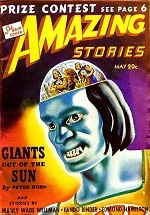

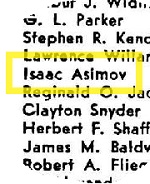 list of correct respondents to the story contest list of correct respondents to the story contest

| | “The Time-Wise Guy”
by Ralph Milne Farley
First publication: Amazing, May 1940

The kindly Professor Tyrrell invites his most worthy student, football player George Worthey, to his house after class to debate over the feasibility of time travel, all the time knowing that he can prove that time travel is possible (modulo certain forbidden treks) by sending George far into the future and instructing him to return a short time later.

The story ends with a challenge to the reader with a total of $50 in cash prizes for the best answers! The answer to the challenge was given in the June issue. Somehow in the answer, George Worthey’s name changed to Sherwin, but I think that was just an editorial mistake. I didn’t much care for Farley’s “correct” answer, although I did spot Isaac Asimov’s name listed among the 112 correct respondents in the July issue. The contest winner was Albert F. Lopez from East Boston, Mass. This contest is one any of our readers can win. It’s extremely simple. You don’t need to know anything about writing. You don’t have to write a story. You aren’t expected to know a great deal of science. All you must do is read the entertaining story “The Time-Wise Guy,” on page 6, and then, in your own words, in a short letter, tell the editors what you think happened to the hero of the story. In other words, how does the story end? This contest is one any of our readers can win. It’s extremely simple. You don’t need to know anything about writing. You don’t have to write a story. You aren’t expected to know a great deal of science. All you must do is read the entertaining story “The Time-Wise Guy,” on page 6, and then, in your own words, in a short letter, tell the editors what you think happened to the hero of the story. In other words, how does the story end?

Your answer should be based on the facts of time travel and its rules, as stated in the story by Professor Tyrrell. Your editors suspect that the correct answer would also shed light on the fate of the Professor’s friend in Holland—rather FROM Holland. But of course, there is a little of George Worthey in all of us, and you may not believe this. Editors don’t know it all, either—

Except that Ralph Milne Farley has kindly supplied us with the answer, and we know it and believe it. We’ll give it to you in the next issue, what’s more, and they you’ll believe it too. 
| |
| | | | |

 | | | | 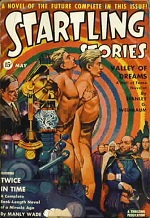 | | Twice in Time
by Manley Wade Wellman
First publication: Startling Stories, May 1940

 Inventor Leo Thrasher, perhaps the last modern-day Renaissance man, builds a machine to throw him back to Renaissance Italy, where he plans to leave his mark as a painter. Once there, he’s taken under the wing of Guaracco who views him as a potential rival, but still sees a use for the time traveler. When Leo’s memory of future wonders begins to fade, Guaracco pulls 20th-century memories from Leo’s subconscious via hypnotic interviews, somehow even managing to pull out (among other more mundane things) a working pair of wings for Leo to fly over 15th-century Florence. Inventor Leo Thrasher, perhaps the last modern-day Renaissance man, builds a machine to throw him back to Renaissance Italy, where he plans to leave his mark as a painter. Once there, he’s taken under the wing of Guaracco who views him as a potential rival, but still sees a use for the time traveler. When Leo’s memory of future wonders begins to fade, Guaracco pulls 20th-century memories from Leo’s subconscious via hypnotic interviews, somehow even managing to pull out (among other more mundane things) a working pair of wings for Leo to fly over 15th-century Florence. But suppose this me is taken completely out of Twentieth Century existence—dematerialized, recreated in another epoch. That makes twice in time, doesn’t it? But suppose this me is taken completely out of Twentieth Century existence—dematerialized, recreated in another epoch. That makes twice in time, doesn’t it? 
| |
| | | | |

 
 
 
 
 
 
 
 | | | | 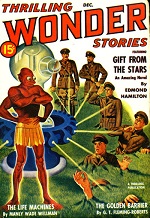 | | “The Blonde, the Time Machine and Johnny Bell”
by Kenneth L. Harrison
First publication: Thrilling Wonder Stories, Dec 1940

Johnny Bell, a reporter for the Clarion, expected to get a story out of Pop Keller’s Curiosity Shop. What he didn’t expect to find were a blonde who looks like Betty Grable who cons him into buying a used time machine.

This was a $25 contest winner story, but Harrison, 23 at the time and living in Portland, Oregon, never published another story. But the strangest thing he had ever seen was the queer-looking mechanical apparatus in the center of the window. Johnny Bell’s gray eyes narrowed in perplexity as he read the advertising card atop it: But the strangest thing he had ever seen was the queer-looking mechanical apparatus in the center of the window. Johnny Bell’s gray eyes narrowed in perplexity as he read the advertising card atop it:
TIME MACHINE
FOR SALE—CHEAP  | |
| | | | |

 | | | | 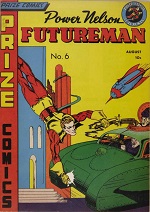 Norris’s first and last Power Nelson cover for Prize Comics 6 Norris’s first and last Power Nelson cover for Prize Comics 6 | | Power Nelson, Futureman
by Dick Sprang (issues 1-6?) and Paul Norris (as by Roy Paul)
First time travel: Prize Comics 7, 12 Dec 1940

 From the first issue of Prize Comics, Power Nelson, aka Futureman, used his superpowers to fight the evil Mongol horde that conquered all of civilization in the far-future year 1982. I’ve read many of the escapades of the red-and-yellow champion of democracy (through Prize Comics 23), but I haven’t yet found issue #7 and the story “Journey to 1940.” (The issue is highly prized, being identified as the first horror comic because of its modern Frankenstein story; it also has the first Simon and Kirby Black Owl story.) Later issues do have Power Nelson fighting Nazis and fifth columnists who are attempting to undermine America, but I’m unclear on whether they are World War II Nazis or 1982 cohorts of the horde. From the first issue of Prize Comics, Power Nelson, aka Futureman, used his superpowers to fight the evil Mongol horde that conquered all of civilization in the far-future year 1982. I’ve read many of the escapades of the red-and-yellow champion of democracy (through Prize Comics 23), but I haven’t yet found issue #7 and the story “Journey to 1940.” (The issue is highly prized, being identified as the first horror comic because of its modern Frankenstein story; it also has the first Simon and Kirby Black Owl story.) Later issues do have Power Nelson fighting Nazis and fifth columnists who are attempting to undermine America, but I’m unclear on whether they are World War II Nazis or 1982 cohorts of the horde.

Wikipedia cites Paul Norris (the Brick Bradford strip artist) as the creator of Power Nelson, but the Grand Comics Database gives a tentative identification of Dick Sprang as the artist for the first six stories, with Norris’s first works being the cover of Prize Comics 6 and the “Journey to 1940” story in issue 7. His first signed work, as by Roy Paul, is the Power Nelson story in issue 13. I’ll do something about this! I’ll do something about this! 

—splash page of “Power Nelson, Man of the Future” in Prize Comics 1
| |
| | | | |

 
No Time Travel. Move along. |
“The Wheels of If” by L. Sprague de Camp, Unknown, Oct 1940 [alternate timelines ]

| |     |